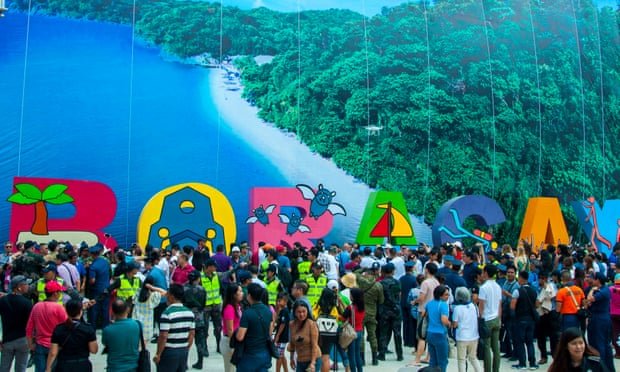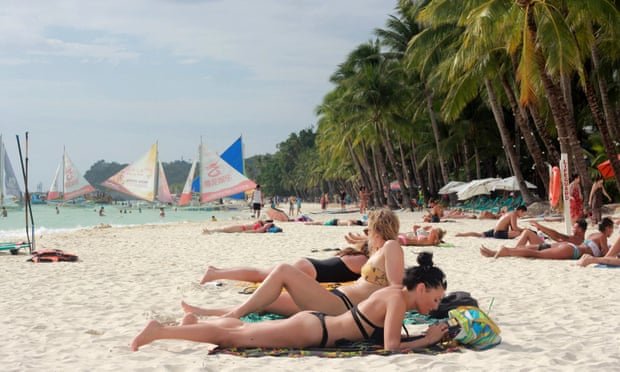Philippines tourism hotspot limits visitor numbers and clears out casinos and beach vendors

Hannah Ellis-Petersen and agencies
Fri 26 Oct 2018 05.48 BST First published on Fri 26 Oct 2018 02.09 BST
Shares
1,694
Tourists arrive on the island of Boracay in the Philippines on Friday.
Tourists arrive on the island of Boracay in the Philippines on Friday. Photograph: Jo Haresh Tanodra/EPA
The Philippines has reopened its famous holiday island of Boracay – spruced up and newly regulated after it was closed to mend decades of harm caused by unchecked tourism.
The sandy idyll was closed to visitors in April after President Rodrigo Duterte called it a “cesspool” tainted by raw sewage flowing from hotels and restaurants straight into the sea.
But the rechristened resort has a slew of new rules that restrict drinking on the beach, limit the number of tourists and hotels, all while renovations continue.
Under the new regime, the beachfront has been cleared of the masseuses, vendors, bonfires and even the builders of its famous photo-op sandcastles. Buildings have been bulldozed and businesses pushed back to create a 30-metre buffer zone from the waterline.
All water sports, including scuba diving, jet skiing and kit-boarding, have also been banned for the time being while a marine assessment is carried out by divers and marine biologists this week.
Boracay’s three casinos have also been permanently closed, in line with Duterte’s wishes.
Thailand bay made famous by The Beach closed indefinitely
Read more
Years of overdevelopment on the tiny island – which previously handled 2 million tourists a year – had left it soiled, crowded and pushed to its limits.
Cabinet and local government officials unveiled a billboard-size image of Boracay’s Puka Beach on Friday, before declaring the island “officially open to all”.
Michael A Martillano, the president of the island’s diving association, who is taking part in the marine assessment of Boracay this week, told the Guardian the water quality, corals and marine life had “really improved” in the past six months.

A Boracay beach in April, before the closure of the holiday island.
Facebook Twitter Pinterest
A Boracay beach in April, before the closure of the holiday island. Photograph: STR/AFP/Getty Images
But he admitted that some of the new restrictions, particularly on parties, would be a “big adjustment for all of us”.
Sign up to The Flyer: weekly travel inspiration, emailed direct to you
Read more
Drinking and smoking are banned on the beach and the huge multi-day beach parties dubbed “LaBoracay” that drew tens of thousands of tourists during the 1 May labour day weekend will be a thing of the past.
“Boracay has been known as one of the best destinations for a laidback island where you could party any time you want, often on the beach, but now that won’t happen in the same way,” said Martillano. “It’s still going to be fun but the old habits of doing whatever you want, whenever you want to party, that will be the biggest change and probably tough for some people.”
The fact that diving and water sports remained suspended was “ a bit of a bummer for us, very frustrating”, said Martillano, but overall he was optimistic about the future of Boracay.
“It’s now going to be a different mentality for everyone who will enter Boracay, whether you are a tourist, or a local or a worker on the island,” he said. “Have a good time but also take care of mother nature.”
Boracay, which major tourist magazines consistently rate as among the world’s best beaches, measures a mere 1,000 hectares (2,500 acres).
Hi! I am a robot. I just upvoted you! I found similar content that readers might be interested in:
https://www.theguardian.com/world/2018/oct/26/party-island-of-boracay-reopens-minus-drinking-smoking-and-raw-sewage
hi